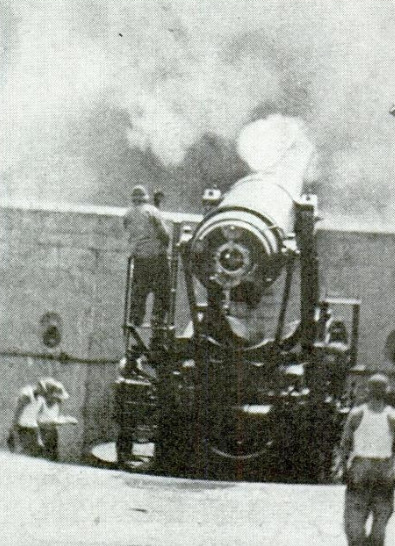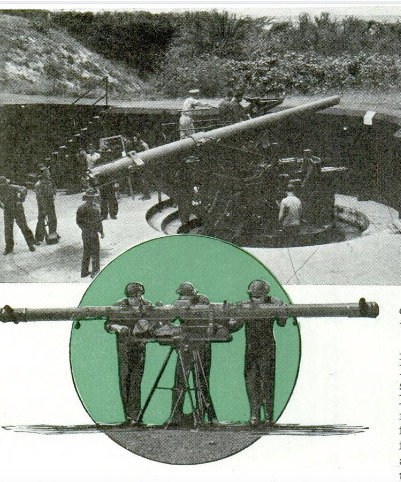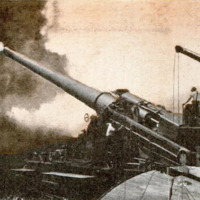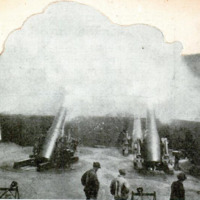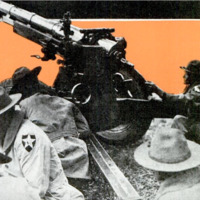UUPPOSE you were be-K 7 hind a hill with your gun, while a man on top of the hill told you over the phone where the game was. and you tried to hit it without ever seeing it at all.
A ridiculous futility, you say, but that sort of shooting is everyday work to the artilleryman. It is seldom that the men who fire the guns ever see what they are shooting at.
Your coast-defense gunner has the easiest job of all, for the permanent installation of these guns permits a long and accurately plotted base line, and a wealth of specially calibrated instruments simplify the problem.
And the problem needs simplifying, for the effective range of a big seacoast gun is twenty-six miles. Its normal target will be a battleship moving thirty miles an hour. The gunners’ view will be blocked completely by fortifications, even when mist, smoke screens or distance do not conceal the ship. To score hits, the gunners must be furnished with the ship’s direction, distance, course and speed. And the gunner cannot aim where the ship is at the moment, for it takes more than three minutes for the huge projectile to reach its destination at extreme range, during which time the ship will travel a mile and a half. At these long ranges there are many things to be considered that the hunter need never worry about—the so-called “variables,” that cause the shell to deviate from its normal trajectory. In a vacuum that trajectory would be a symmetrical curve, but air resistance slows down the shell so that it falls at a much greater angle than it arises. The altitude attained by a sixteen-inch shell at maximum range is more than twelve miles, so not only must the density of the air at sea level be computed, but the varying densities of all the higher layers of air that the shell must pass through. Barometer and humidity readings are always possible at sea level, and the higher readings may be obtained by airplane or balloon in peacetime. But during war it seldom will be possible to obtain such readings when needed, so tables of averages, based on sea-level readings, must be used. This factor is far from trifling, for air density can cause a fifteen-per-cent possible error—one and three-fourths miles at maximum range.
The velocity and direction of wind, from sea level to stratosphere, must also be known or estimated, for a twenty-mile wind will carry a shell a full mile off its course during the three minutes it is in the air. The wind might vary from ten miles an hour at sea level to eighty miles an hour at the top of the trajectory; so these varying forces must be computed ac-cording to the length of time they affect the shell.
And at those long ranges, the earth can no longer be considered a stationary flat object. Both its curvature and rotation must be allowed for. A gun firing north, for instance, must be aimed 175 yards east of the target at maximum the target at maximum range, else the earth will have rolled the target out from under the descending shell. Rising or falling tide will also affect range, by changing the elevation of the target in relation to the gun. Powder temperature is another variable. Warm powder burns faster than cold, a change of ten degrees causing a difference of 300 yards in the distance the same amount of powder will hurl a shell. These huge projectiles, weighing more than a ton, will vary a few pounds too, thus varying the distance which a standard charge of powder will hurl them.
(Continued to page 144A)
Sharpshooting at Unseen Targets
(Continued from page 811)
So that the gunner can hit the invading ship, all these things must be figured out for him. Range and direction are simple problems in trigonometry and a clever device called a plotting board has been developed to solve these problems automatically and instantly.
A coast-defense fort will have base-end stations, perhaps several miles away, on either side of the guns. Usually they are placed on some high point of ground that permits observation many miles to seaward. These stations will be at known distances from the guns, and will be connected to the plotting room by telephone.
Observers at each station pick up the enemy ship with their telescopes, which are mounted over a graduated dial. Hav-ing the ship spotted at the cross hairs, they read the dial pointer and phone the azimuth reading to the plotting room, where a miniature range is laid out on the plotting board. This board is a semi-circular table, graduated around its edge, and equipped with three arms, which are placed in the same proportional relationship to each other as are the two base-end stations to the guns. As the observers report the azimuths from their stations to the target, men set the arms of the plotting board to those same angles. This causes the third or gun arm to automatically point to the azimuth that the target is from the gun; while at the same time the movement of the plotting arms causes a slide on the graduated gun arm to indicate the range. Actual distance and direction from gun to target are thus read at a glance.
But this information is not enough for the gunner. A man sits at the range correction board, making adjustments fox' all the variables that affect range, so that when the actual range is called out to him, he need only set that range on the board to read off the corrected range, which the board automatically computes. Another man operates the deflection board, adjusting the variables that affect lateral direction. Then by setting the actual direction on the board, he can read the corrected azimuth instantly.
In the meantime the observers at the base-end stations track the moving target, reporting the changed azimuths every minute, or other interval in which it is desired to fire the guns. After four or five such reports, the plotting officer has a line of four or five dots on the plotting board, which show him the course and speed of the ship. This enables him to plot the point where it will be at the instant he desires to have the guns fired. Next he consults a slide rule to show him how far the ship will travel while the projectile is in the air, and sets this distance off on the plotted course. This gives him the set-forward point—the point where the guns are to be aimed. The correction is applied to this range and azimuth, and the information is transmitted to the guns by phone or visual indicator.
When the first shot is fired, the base-end observers’ job changes. They now watch for shell splashes, and report the angle, read by a scale etched on the telescope lens, between the splash and the target. The plotting crew set these two angles on the spotting board, which automatically computes the error for that shot, in both distance and direction.
The officer at the plotting board makes these corrections in computing future setforward points, and this procedure continues until the target is destroyed. Often ten or more shots are fired before the target is hit; but with three or four projectiles on their way at once from the same gun, spotting corrections cannot be applied until that number of shots intervene.
While this method of spotting and target location is the most accurate possible, it probably will never be used in a future war; for a modern fleet would be concealed from the shore by a smoke screen, laid down by destroyers or airplanes. In that case it would be necessary to locate the target and adjust fire by aerial observation. The plane would first fly on the far side of the enemy ship, and radio the compass bearing of the ship from two prominent landmarks on shore. Lines would be drawn on the chart from these landmarks, at the designated angles, the location of the target being where these lines cross. The airplane observer would then determine the course of the ship, and would estimate its speed: then when the firing commenced, he would observe the splashes, reporting their location with regard to the target.
Naval gunners have exactly the same problems in firing the big guns aboard the battleships: but with added complications. For not only is the enemy ship moving, but so is the ship from which the guns are fired. And a ship permits of no long base line from which accurate triangulation is possible. Instead, an optical range finder, with a base of only thirty feet, must be used. This instrument is so designed that when a true image of the target appears in the eyepiece, range and direction may be read direct from a scale. This information is set on an amazingly intricate machine called a director, along with data on the variables, and the courses and speeds of both ships. The director automatically and instantly computes set-forward points, and by an electrical hook-up, aims the turret guns, which may all be fired together at a touch of the gunnery officer’s finger.
The roll and pitch of a ship in a heavy sea adds another complication. It readily can be seen that the guns must be aimed in
(Continued to page 149A>
relation to the surface of the earth, rather than the ever-changing angle of the deck,. else ranges become meaningless. To compensate for roll and pitch, the navy has perfected a mechanical device which corrects for the ship’s motion at the instant of firing. These marvelous devices are among the navy’s most guarded secrets; no one ever being permitted to see them except those entrusted with their operation.
The fleet carries its own observation planes, either on carriers or on catapults of the fighting ships, to locate the enemy and to adjust fire by observing the splashes. - The problem of field artillery that accompanies the mobile army is simpler in well-mapped country, for with gun and target accurately located on a map, the direction and range can be read directly, using a protractor and map scale.
But maps suitable for fire-control purposes are available for only a small portion of the earth’s surface. And without such maps, every artillery problem becomes a complicated computation in trigonometry, for field artillery cannot carry the cumbersome and delicate instruments used by the navy and coast artillery to solve their problems mechanically.

